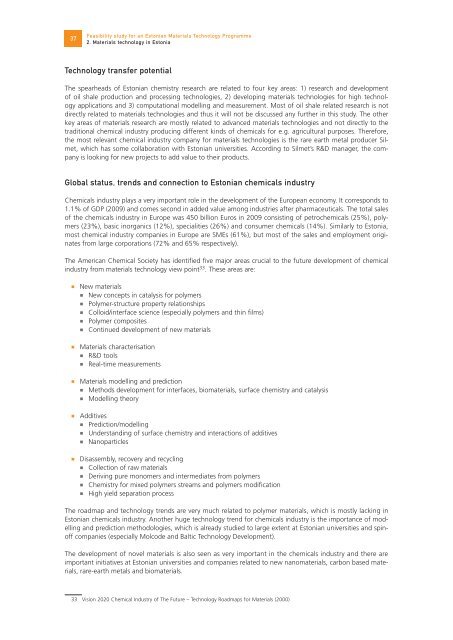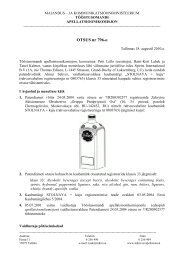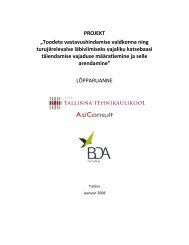Feasibility study for an Estonian Materials Technology Programme
Feasibility study for an Estonian Materials Technology Programme
Feasibility study for an Estonian Materials Technology Programme
Create successful ePaper yourself
Turn your PDF publications into a flip-book with our unique Google optimized e-Paper software.
37<br />
<strong>Feasibility</strong> <strong>study</strong> <strong>for</strong> <strong>an</strong> Estoni<strong>an</strong> <strong>Materials</strong> <strong>Technology</strong> <strong>Programme</strong><br />
2. <strong>Materials</strong> technology in Estonia<br />
<strong>Technology</strong> tr<strong>an</strong>sfer potential<br />
The spearheads of Estoni<strong>an</strong> chemistry research are related to four key areas: 1) research <strong>an</strong>d development<br />
of oil shale production <strong>an</strong>d processing technologies, 2) developing materials technologies <strong>for</strong> high technology<br />
applications <strong>an</strong>d 3) computational modelling <strong>an</strong>d measurement. Most of oil shale related research is not<br />
directly related to materials technologies <strong>an</strong>d thus it will not be discussed <strong>an</strong>y further in this <strong>study</strong>. The other<br />
key areas of materials research are mostly related to adv<strong>an</strong>ced materials technologies <strong>an</strong>d not directly to the<br />
traditional chemical industry producing different kinds of chemicals <strong>for</strong> e.g. agricultural purposes. There<strong>for</strong>e,<br />
the most relev<strong>an</strong>t chemical industry comp<strong>an</strong>y <strong>for</strong> materials technologies is the rare earth metal producer Silmet,<br />
which has some collaboration with Estoni<strong>an</strong> universities. According to Silmet’s R&D m<strong>an</strong>ager, the comp<strong>an</strong>y<br />
is looking <strong>for</strong> new projects to add value to their products.<br />
Global status, trends <strong>an</strong>d connection to Estoni<strong>an</strong> chemicals industry<br />
Chemicals industry plays a very import<strong>an</strong>t role in the development of the Europe<strong>an</strong> economy. It corresponds to<br />
1.1% of GDP (2009) <strong>an</strong>d comes second in added value among industries after pharmaceuticals. The total sales<br />
of the chemicals industry in Europe was 450 billion Euros in 2009 consisting of petrochemicals (25%), polymers<br />
(23%), basic inorg<strong>an</strong>ics (12%), specialities (26%) <strong>an</strong>d consumer chemicals (14%). Similarly to Estonia,<br />
most chemical industry comp<strong>an</strong>ies in Europe are SMEs (61%), but most of the sales <strong>an</strong>d employment originates<br />
from large corporations (72% <strong>an</strong>d 65% respectively).<br />
The Americ<strong>an</strong> Chemical Society has identified five major areas crucial to the future development of chemical<br />
industry from materials technology view point 33 . These areas are:<br />
New materials<br />
New concepts in catalysis <strong>for</strong> polymers<br />
Polymer-structure property relationships<br />
Colloid/interface science (especially polymers <strong>an</strong>d thin films)<br />
Polymer composites<br />
Continued development of new materials<br />
<strong>Materials</strong> characterisation<br />
R&D tools<br />
Real-time measurements<br />
<strong>Materials</strong> modelling <strong>an</strong>d prediction<br />
Methods development <strong>for</strong> interfaces, biomaterials, surface chemistry <strong>an</strong>d catalysis<br />
Modelling theory<br />
Additives<br />
Prediction/modelling<br />
Underst<strong>an</strong>ding of surface chemistry <strong>an</strong>d interactions of additives<br />
N<strong>an</strong>oparticles<br />
Disassembly, recovery <strong>an</strong>d recycling<br />
Collection of raw materials<br />
Deriving pure monomers <strong>an</strong>d intermediates from polymers<br />
Chemistry <strong>for</strong> mixed polymers streams <strong>an</strong>d polymers modification<br />
High yield separation process<br />
The roadmap <strong>an</strong>d technology trends are very much related to polymer materials, which is mostly lacking in<br />
Estoni<strong>an</strong> chemicals industry. Another huge technology trend <strong>for</strong> chemicals industry is the import<strong>an</strong>ce of modelling<br />
<strong>an</strong>d prediction methodologies, which is already studied to large extent at Estoni<strong>an</strong> universities <strong>an</strong>d spinoff<br />
comp<strong>an</strong>ies (especially Molcode <strong>an</strong>d Baltic <strong>Technology</strong> Development).<br />
The development of novel materials is also seen as very import<strong>an</strong>t in the chemicals industry <strong>an</strong>d there are<br />
import<strong>an</strong>t initiatives at Estoni<strong>an</strong> universities <strong>an</strong>d comp<strong>an</strong>ies related to new n<strong>an</strong>omaterials, carbon based materials,<br />
rare-earth metals <strong>an</strong>d biomaterials.<br />
33 Vision 2020 Chemical Industry of The Future – <strong>Technology</strong> Roadmaps <strong>for</strong> <strong>Materials</strong> (2000)





